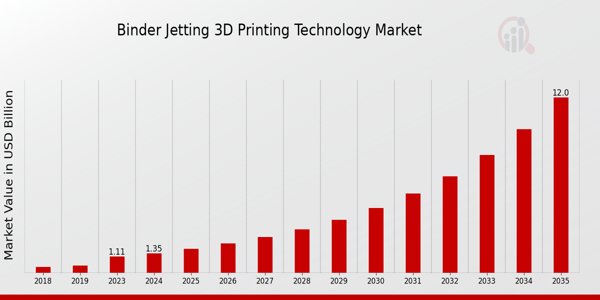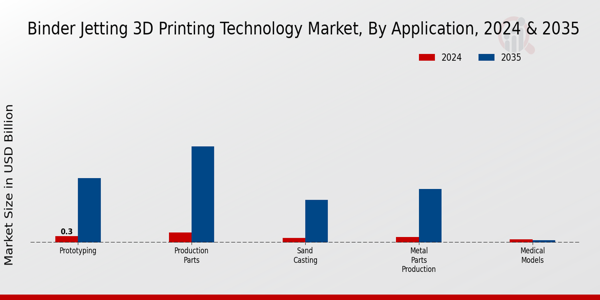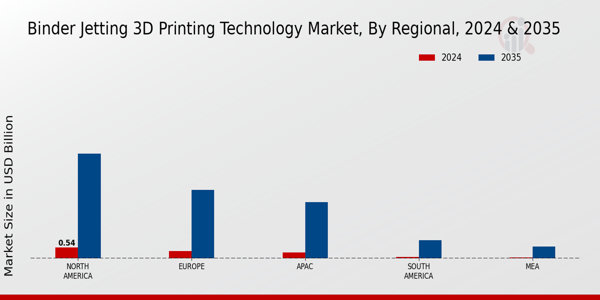Binder Jetting 3D Printing Technology Market Overview
As per MRFR analysis, the Binder Jetting 3D Printing Technology Market Size was estimated at 1.11 (USD Billion) in 2023. The Binder Jetting 3D Printing Technology Market Industry is expected to grow from 1.35 (USD Billion) in 2024 to 12.0 (USD Billion) by 2035. The Binder Jetting 3D Printing Technology Market CAGR (growth rate) is expected to be around 21.97% during the forecast period (2025 - 2035).
Key Binder Jetting 3D Printing Technology Market Trends Highlighted
The Global Binder Jetting 3D Printing Technology Market is experiencing significant growth driven by various key factors. Increasing demand for customized products across industries such as automotive, aerospace, and healthcare is pushing manufacturers to adopt more flexible and efficient production methods. The ability of binder jetting technology to create intricate designs with less material waste enhances its appeal, allowing businesses to meet stringent environmental regulations while reducing costs. Moreover, advancements in materials used for binder jetting, including metals and ceramics, are expanding the scope of applications, further propelling market expansion.
There are also numerous opportunities to be explored within the binder jetting space. With growing interest in sustainable manufacturing practices, businesses have a chance to innovate and develop eco-friendly materials suited for binder jetting processes. Collaborations between material developers and technology providers may lead to the creation of unique materials that enhance the capabilities of binder jetting technology. Furthermore, the rise of digital and on-demand manufacturing presents a favorable environment for this technology, as it offers solutions for producing small batch sizes without significant investment in traditional manufacturing setups.
In recent times, trends such as increased automation and integration of artificial intelligence in manufacturing processes are becoming more prominent. These advancements enable more efficient production operations, reduce lead times, and improve overall quality. Additionally, the growing adoption of Industry 4.0 concepts is pushing companies to implement smart manufacturing solutions which include binder jetting technology. The evolution of software solutions for designing and managing 3D printing processes has also made it easier for companies to harness the full potential of binder jetting, ensuring smoother workflows and enhanced productivity. Overall, the market is positioning itself to meet the future demands of various sectors.

Source: Primary Research, Secondary Research, MRFR Database and Analyst Review
Binder Jetting 3D Printing Technology Market Drivers
Rapid Advancement in 3D Printing Technologies
The Global Binder Jetting 3D Printing Technology Market Industry is experiencing rapid advancements in 3D printing technologies, which play a significant role in propelling market growth. As technology evolves, the capabilities of binder jetting systems continue to improve, leading to enhanced printing speed, precision, and material diversity. This technological evolution allows manufacturers to produce complex geometries and intricate designs that were previously unattainable with conventional manufacturing methods. Increased accuracy and reduced print times enable industries to adopt 3D printing solutions more readily, thereby fostering widespread adoption across various sectors such as aerospace, automotive, and healthcare. Additionally, the burgeoning demand for customized products and intricate designs promotes the development of innovative binder jetting technologies. Furthermore, advancements in software, such as improved simulation and design tools, facilitate seamless integration into existing manufacturing workflows, reinforcing the adoption of binder jetting.
Continuous investments in research and development by market participants to improve their technologies sustains an optimistic outlook for the Global Binder Jetting 3D Printing Technology Market Industry.
Growing Demand for Customization
The increasing demand for customization in product design and manufacturing is a prominent driver for the growth of the Global Binder Jetting 3D Printing Technology Market Industry. In today's competitive landscape, consumers and businesses alike require tailored solutions that meet specific needs and preferences. Binder jetting technology enables manufacturers to create personalized items with intricate designs, leading to increased customer satisfaction and improved brand loyalty. Sectors such as consumer electronics, healthcare, and fashion are recognizing the benefits of customized products, which often result in reduced waste and efficient production processes. The ability to quickly transition from design to prototype to final product using binder jetting techniques allows businesses to reduce time-to-market, thereby enhancing their competitive edge in the industry.
Sustainability and Environmental Concerns
Sustainability and environmental concerns are increasingly driving the adoption of the Global Binder Jetting 3D Printing Technology Market Industry. A growing emphasis on eco-friendly manufacturing practices compels industries to explore innovative solutions that minimize waste and resource consumption. Binder jetting technology is perceived as a more sustainable alternative compared to traditional manufacturing methods, as it produces parts with minimal material waste. By using only the necessary amount of binding material, manufacturers can considerably reduce excess and leftover materials. Moreover, the capability to use eco-friendly materials in the binder jetting process further contributes to its appeal among environmentally conscious consumers and businesses alike. This trend toward sustainable practices is expected to continually influence market growth by encouraging businesses to adopt greener technologies.
Binder Jetting 3D Printing Technology Market Segment Insights
Binder Jetting 3D Printing Technology Market Application Insights
In the Global Binder Jetting 3D Printing Technology Market, the Application segment shows a robust trajectory with a projected valuation of 1.35 USD Billion in 2024, expanding to 12.0 USD Billion by 2035. This remarkable growth trajectory is driven by the increasing adoption of 3D printing technology across various sectors, facilitating efficient manufacturing processes and reducing costs. Within this segment, Prototyping holds a significant position, valued at 0.3 USD Billion in 2024 and expected to reach 3.0 USD Billion in 2035. This dominance stems from the necessity of rapid prototyping in product development, allowing companies to test designs before full-scale production, thereby minimizing errors and accelerating time-to-market. Following closely is the Production Parts application, which is valued at 0.45 USD Billion in 2024 and is anticipated to grow to 4.5 USD Billion by 2035. This application is vital in the manufacturing sector as it supports the production of complex geometries that traditional methods struggle to achieve, enhancing design flexibility and product innovation.
Sand Casting also plays a critical role in the Binder Jetting 3D Printing Technology Market, holding a valuation of 0.2 USD Billion in 2024, set to rise to 2.0 USD Billion in 2035. The significant growth of this application signifies effective solutions in producing intricate sand molds faster than conventional methods. On the other hand, Metal Parts Production stands at a valuation of 0.25 USD Billion in 2024, rising to 2.5 USD Billion by 2035, demonstrating its importance in industries that require high-strength components, such as aerospace and automotive, thereby underscoring strong demand for precise and durable parts.
Lastly, the Medical Models application, while valued lower at 0.15 USD Billion in 2024, is expected to decline slightly to 0.1 USD Billion in 2035. This indicates a niche segment focused on personalized healthcare solutions, showcasing the technology's potential in creating anatomical models for surgical planning. The overall dynamics within the Application segmentation of the Binder Jetting 3D Printing Technology Market reveal a landscape that is increasingly being shaped by technological advancements, market demands for customization, and the integration of 3D printing in traditional manufacturing processes, highlighting significant opportunities for innovation and investment.

Source: Primary Research, Secondary Research, MRFR Database and Analyst Review
Binder Jetting 3D Printing Technology Market Material Type Insights
This segment is characterized by its diverse offerings, including Plastic, Metal, Ceramics, and Composites, each playing a crucial role in the market's expansion. Plastics account for a substantial part of the market due to their lightweight nature and versatility, making them ideal for prototyping and production applications. Metal materials are gaining traction as industries seek strong, durable components, which drive the growth of this segment, particularly in sectors such as aerospace and automotive.
Ceramics are appreciated for their heat resistance and are increasingly utilized in the manufacturing of intricate medical devices and dental applications. Composites, known for their enhanced properties, cater to specialized applications where strength and flexibility are essential, thereby dominating niche markets. With the Global Binder Jetting 3D Printing Technology Market Statistics forecasting diverse applications across sectors, the industry is set for robust growth, driven by the increasing demand for advanced materials and innovative manufacturing solutions. This segment is expected to influence the overall market dynamics substantially, presenting various opportunities and challenges in terms of material development and operational efficiency.
Binder Jetting 3D Printing Technology Market Technology Type Insights
The Global Binder Jetting 3D Printing Technology Market is projected to experience significant growth. Within this market, various technology types play crucial roles. Binder Jetting stands out as a prominent method due to its efficient material usage and ability to produce complex geometries with high levels of detail, which appeals to a range of industries. Multi-Jet Fusion is recognized for its speed and capability to create functional parts with excellent mechanical properties, making it a favored choice for production applications.PolyJet technology offers versatility with its multi-material printing capability, enabling the production of intricate and colorful prototypes. Selective Laser Sintering remains significant due to its robustness and the ability to handle a variety of polymers and metals, thus catering to industries that demand high-performance components. The Global Binder Jetting 3D Printing Technology Market segmentation reflects varying applications of these technologies, driven by trends in rapid prototyping and customization, as well as increasing demand for sustainable manufacturing practices.
The market is not without challenges, including material limitations and competition from alternative methods, yet it offers opportunities for innovations and expanding applications within diverse sectors.
Binder Jetting 3D Printing Technology Market End Use Industry Insights
The Global Binder Jetting 3D Printing Technology Market is evolving rapidly, with notable growth expected in End Use Industries such as Aerospace, Automotive, Healthcare, Consumer Goods and Architecture. The Aerospace industry is known for adopting advanced manufacturing techniques to reduce weight and improve performance, making it a crucial sector in the binder jetting landscape. In contrast, the Automotive sector leverages this technology for prototyping and production efficiency, which enhances production timelines and reduces costs.
Healthcare is increasingly using binder jetting 3D printing for creating custom implants and prosthetics, demonstrating the technology's importance in personalized medicine. The Consumer Goods sector benefits from reduced lead times and the ability to produce complex designs that meet consumer demands. Lastly, Architecture utilizes binder jetting to create intricate architectural models, allowing for greater design freedom and faster project completion. The robust growth drivers, evolving technological capabilities, and increasing demand for customized solutions create substantial opportunities across these industries, enhancing the overall dynamics and statistics of the Global Binder Jetting 3D Printing Technology Market.
Binder Jetting 3D Printing Technology Market Regional Insights
The Regional segment of the Global Binder Jetting 3D Printing Technology Market highlights significant growth across various areas, with North America leading in market revenue at 0.54 USD Billion in 2024 and projected to expand to 5.2 USD Billion by 2035, demonstrating its majority holding in the industry. Europe follows with a strong valuation of 0.37 USD Billion in 2024, expected to grow to 3.4 USD Billion, emphasizing its critical role in technological advancements and application across sectors. The APAC region, valued at 0.3 USD Billion in 2024 and anticipated to reach 2.8 USD Billion by 2035, indicates increasing adoption of 3D printing technologies in manufacturing and prototyping.
South America and MEA show smaller market valuations at 0.08 USD Billion and 0.06 USD Billion in 2024, respectively, with their projected growth to 0.9 USD Billion and 0.6 USD Billion by 2035 showcasing emerging opportunities in these regions. Overall, the Global Binder Jetting 3D Printing Technology Market segmentation reveals a diverse landscape, with North America and Europe playing pivotal roles in shaping market trends and innovations while APAC presents significant potential for future growth.

Source: Primary Research, Secondary Research, MRFR Database and Analyst Review
Binder Jetting 3D Printing Technology Market Key Players and Competitive Insights
The Global Binder Jetting 3D Printing Technology Market is experiencing rapid growth and diversification due to advancements in additive manufacturing. This technology facilitates the efficient production of complex geometries using various binding agents and powdered materials. The competitive landscape of the market is marked by significant innovations and enhancements aimed at addressing customer needs across sectors such as aerospace, automotive, and healthcare. Companies are incorporating advanced materials and expanding their capabilities while emphasizing sustainability and cost-effectiveness. The competitive interplay among key players is underscored by their strategies concerning research and development, partnerships, and market expansion, paving the way for a promising future in the binder jetting ecosystem.
Sandvik has made notable strides in the Global Binder Jetting 3D Printing Technology Market with its robust expertise in materials engineering and manufacturing. Their strengths lie in developing highperformance around metal and alloy powders optimized for binder jetting processes, consequently enhancing the mechanical properties of printed components. Sandvik's established presence in various industrial sectors further amplifies its competitive edge as it leverages its advanced R&D capabilities to innovate and adapt to evolving market demands. The company's investments in digital manufacturing technologies, coupled with strategic collaborations, position it favorably for leading the charge in enhancing the efficiency and versatility of binder jetting applications while maintaining a focus on sustainability and material quality.
Voxeljet has also established itself as a key player in the Global Binder Jetting 3D Printing Technology Market, showcasing distinct strengths in providing high-speed, large-format 3D printing solutions. The company is recognized for its cutting-edge binder jetting technology, which enables the production of intricate patterns and detailed designs in a range of materials, including metals and ceramics. Voxeljet has cultivated a significant market presence through its commitment to innovation and customer service, particularly by offering a diverse portfolio of applications that cater to industries such as automotive, art, and architecture. The company's emphasis on rapid prototyping and production efficiency makes it an attractive option for businesses seeking agility and cost reductions in their manufacturing processes, reinforcing its competitive position in this dynamic market landscape.
Key Companies in the Binder Jetting 3D Printing Technology Market Include
- Sandvik
- Voxeljet
- Renishaw
- Ford Motor Company
- Materialise
- Siemens
- Nano Dimension
- 3D Systems
- GE Additive
- HP
- ExOne
- Markforged
- Aconity3D
- Stratasys
Binder Jetting 3D Printing Technology Market Industry Developments
In recent developments within the Global Binder Jetting 3D Printing Technology Market, companies like HP and GE Additive have been expanding their product offerings to enhance speed and material variety, capturing increased attention from diverse industries. The market has seen significant activity, with major players such as Sandvik and 3D Systems focusing on sustainable practices and material innovations to cater to evolving consumer demands.
Notably, mergers and acquisitions have been pivotal, with Voxeljet acquiring a strategic partnership to amplify its technological capabilities, alongside similar strategic moves by Materialise and Stratasys aimed at bolstering their market presence. Additionally, Ford Motor Company is exploring the integration of binder jetting technologies for automotive parts, indicating a growing trend towards practical applications of this technology. Furthermore, market valuations for companies like Nano Dimension and Renishaw have surged, reflecting increased investment interest and technological advancements that emphasize efficiency and scalability in production processes. This influx of innovations and partnerships characterizes a rapidly evolving market landscape, underscoring the vital role of binder jetting technology in future manufacturing practices.
Binder Jetting 3D Printing Technology Market Segmentation Insights
Binder Jetting 3D Printing Technology Market Application Outlook
- Prototyping
- Production Parts
- Sand Casting
- Metal Parts Production
- Medical Models
Binder Jetting 3D Printing Technology Market Material Type Outlook
- Plastic
- Metal
- Ceramics
- Composites
Binder Jetting 3D Printing Technology Market Technology Type Outlook
- Binder Jetting
- Multi-Jet Fusion
- PolyJet
- Selective Laser Sintering
Binder Jetting 3D Printing Technology Market End Use Industry Outlook
- Aerospace
- Automotive
- Healthcare
- Consumer Goods
- Architecture
Binder Jetting 3D Printing Technology Market Regional Outlook
- North America
- Europe
- South America
- Asia Pacific
- Middle East and Africa
|
Report Attribute/Metric
|
Details
|
|
Market Size 2023
|
1.11 (USD Billion)
|
|
Market Size 2024
|
1.35 (USD Billion)
|
|
Market Size 2035
|
12.0 (USD Billion)
|
|
Compound Annual Growth Rate (CAGR)
|
21.97% (2025 - 2035)
|
|
Report Coverage
|
Revenue Forecast, Competitive Landscape, Growth Factors, and Trends
|
|
Base Year
|
2024
|
|
Market Forecast Period
|
2025 - 2035
|
|
Historical Data
|
2019 - 2024
|
|
Market Forecast Units
|
USD Billion
|
|
Key Companies Profiled
|
Sandvik, Voxeljet, Renishaw, Ford Motor Company, Materialise, Siemens, Nano Dimension, 3D Systems, GE Additive, HP, ExOne, Markforged, Aconity3D, Stratasys
|
|
Segments Covered
|
Application, Material Type, Technology Type, End Use Industry, Regional
|
|
Key Market Opportunities
|
Increased demand for customized production,
Sustainable manufacturing solutions,
Expansion in automotive applications,
Advancements in material variety,
Growth in aerospace component manufacturing
|
|
Key Market Dynamics
|
Technological advancements,
Cost-effectiveness,
Material versatility,
Growing industrial applications,
Environmental sustainability
|
|
Countries Covered
|
North America, Europe, APAC, South America, MEA
|
Frequently Asked Questions (FAQ) :
In 2024, the Global Binder Jetting 3D Printing Technology Market is expected to be valued at 1.35 USD Billion.
By 2035, the market is anticipated to reach a valuation of 12.0 USD Billion.
The expected CAGR for the Global Binder Jetting 3D Printing Technology Market from 2025 to 2035 is 21.97%.
North America is projected to have the largest market size, valued at 5.2 USD Billion in 2035.
The Prototyping application is expected to grow from 0.3 USD Billion in 2024 to 3.0 USD Billion in 2035.
Key players include Sandvik, Voxeljet, Renishaw, Ford Motor Company, and Materialise.
The market size for Metal Parts Production application is expected to be valued at 2.5 USD Billion in 2035.
By 2035, the European market size is expected to reach 3.4 USD Billion.
Potential challenges include technological advancements and competition from alternative manufacturing processes.
The projected market size for South America in 2035 is expected to be 0.9 USD Billion.
















